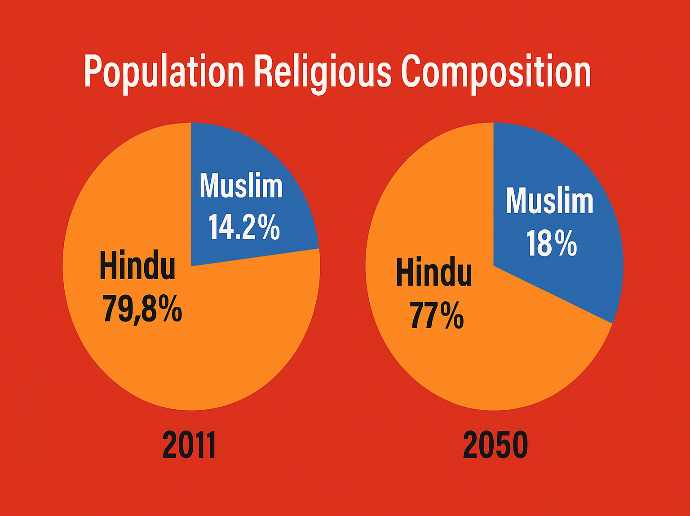– Javeed Golandaj
In recent years, a narrative has circulated – often promoted on social media and in political rhetoric – that India, a Hindu-majority nation, is on the way to becoming a Muslim-majority country. This claim exploits fears of cultural change and demographic invasion, but demographic data, population trends, or expert analyses do not support it. In fact, demographers across ideological lines agree: India will stay a Hindu-majority country for the foreseeable future.
India’s Current Religious Demographics
According to the Census of India 2011, the most recent official data available, Hindus constitute 79.8% of the population, followed by Muslims at 14.2%. Christians account for 2.3%, Sikhs represent 1.7%, and the remaining 2.0% includes other religious communities such as Jains, Buddhists, and Parsis. Over the decades, there has been a gradual shift in the population shares among religious groups, with the Hindu proportion slightly declining and the Muslim share increasing modestly. However, the overall demographic trend remains steady, with Hindus continuing to form an overwhelming majority of the population and Muslims remaining a distant second in terms of national share.
What About Fertility Rates?
The fertility rates vary among religious groups, and this difference is often cited as evidence of an impending Muslim majority. “While Muslims globally have the highest fertility rate – averaging 3.1 children per woman, well above the replacement level of 2.1 – in India, the Muslim fertility rate is considerably lower and has already fallen close to the replacement threshold.”
Data from the National Family Health Survey (NFHS-5, 2019–21) shows a significant decline in Total Fertility Rates (TFR, or the number of children born per woman on average) among both Muslims and Hindus over the past three decades. Muslim TFR decreased from 4.4 in 1992–93 to 2.3 in 2019–21 – a decline of 48% – while Hindu TFR declined from 3.3 to 1.9, a 41% reduction. Although Muslim fertility remains slightly higher, the gap has steadily narrowed, driven by a sharper absolute decline among Muslims (2.1 children per woman) compared to Hindus (1.4), indicating a clear trend towards convergence in fertility patterns. These figures highlight a broader national trend towards population stabilisation rather than demographic growth.
| Converging Fertility Rates | |||
| Groups | 1992-93 | 2019-20 | %Change |
| Hindu | 3.3 | 1.9 | 41.2% |
| Muslim | 4.4 | 2.3 | 47.7% |
| India Total | 3.4 | 2.0 | 41.3% |
Population Projections
Demographic projections by reputable institutions, including the United Nations (2022) and Pew Research Centre (2021), based on long-term fertility, mortality, and migration trends, consistently show that India will retain its Hindu-majority status throughout the 21st century. While the Muslim population is expected to grow in absolute terms, it will not surpass the Hindu population. According to projections by the Pew Research Centre, by 2050, even though India is expected to have the world’s largest Muslim population – exceeding 310 million – Hindus will still constitute a substantial majority at approximately 77%, with Muslims remaining a minority at around 18%. These projections reflect declining fertility and broader demographic stabilisation. Although Muslim fertility is slightly higher, both groups are nearing replacement-level, making a demographic reversal highly unlikely.
The Myth of a Muslim-Majority India
The claim that India is on course to become a Muslim-majority nation lacks empirical demographic foundation and is primarily fuelled by political rhetoric and fear-based narratives. This myth exploits anxieties around religious identity and population growth, reinforcing communal divisions and fostering mistrust toward minorities. Its propagation relies on several tactics: the selective use of outdated fertility data to exaggerate demographic differences, the dismissal of recent trends showing significant fertility decline among Muslims, and the conflation of localised population shifts with national patterns. Furthermore, unsubstantiated slogans such as “demographic invasion” and other inflammatory narratives framing population growth as a form of religious aggression are employed to portray demographic change as a threat, despite the absence of credible evidence. Such distortions of demographic reality serve vested interests, undermining social cohesion and diverting attention from the broader socio-economic challenges that affect all communities.
Drivers of Demographic Change
A range of socio-economic factors has contributed to the decline in fertility across all religious communities in India. Among the most significant are rising levels of education and economic development, particularly among Muslim women, which are closely correlated with reductions in family size. In parallel, processes of urbanisation and expanded access to healthcare and family planning services have further facilitated the shift toward smaller families across the population.
Additionally, the notion that migration is altering India’s religious demography is not supported by empirical evidence. Both official government sources and independent demographic analyses consistently show that migration has a minimal effect on the country’s religious composition, particularly in light of India’s stringent border and immigration controls.
Realities versus Fear
There exists no credible demographic projection under which India becomes a Muslim-majority nation within this century. The numerical gap between the Hindu and Muslim populations remains substantial, and with fertility rates converging steadily, this gap is not expanding but stabilising. Rather than yielding to unfounded demographic anxieties, the national focus should remain on inclusive development, educational advancement, and social cohesion – goals that are universally relevant and essential across all communities.
Ultimately, demographic change in India is shaped by data-driven trends, not ideological speculation. And the data unambiguously affirms that India’s religious composition will remain pluralistic, but with a clear and sustained Hindu majority for the foreseeable future.
[The writer is based in Dharwad, Karnataka. Email: javeediips@gmail.com]




